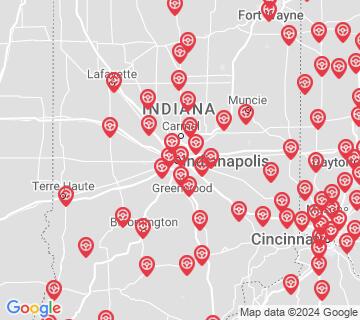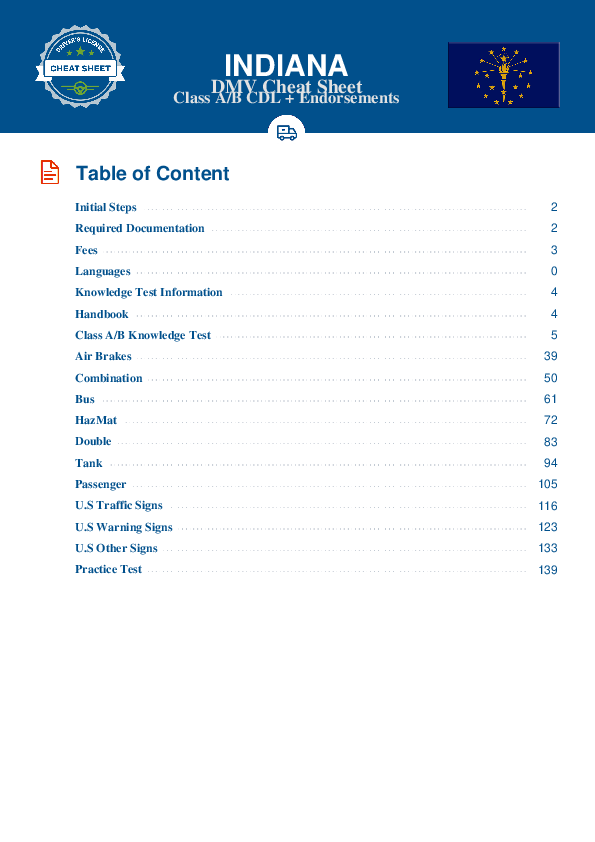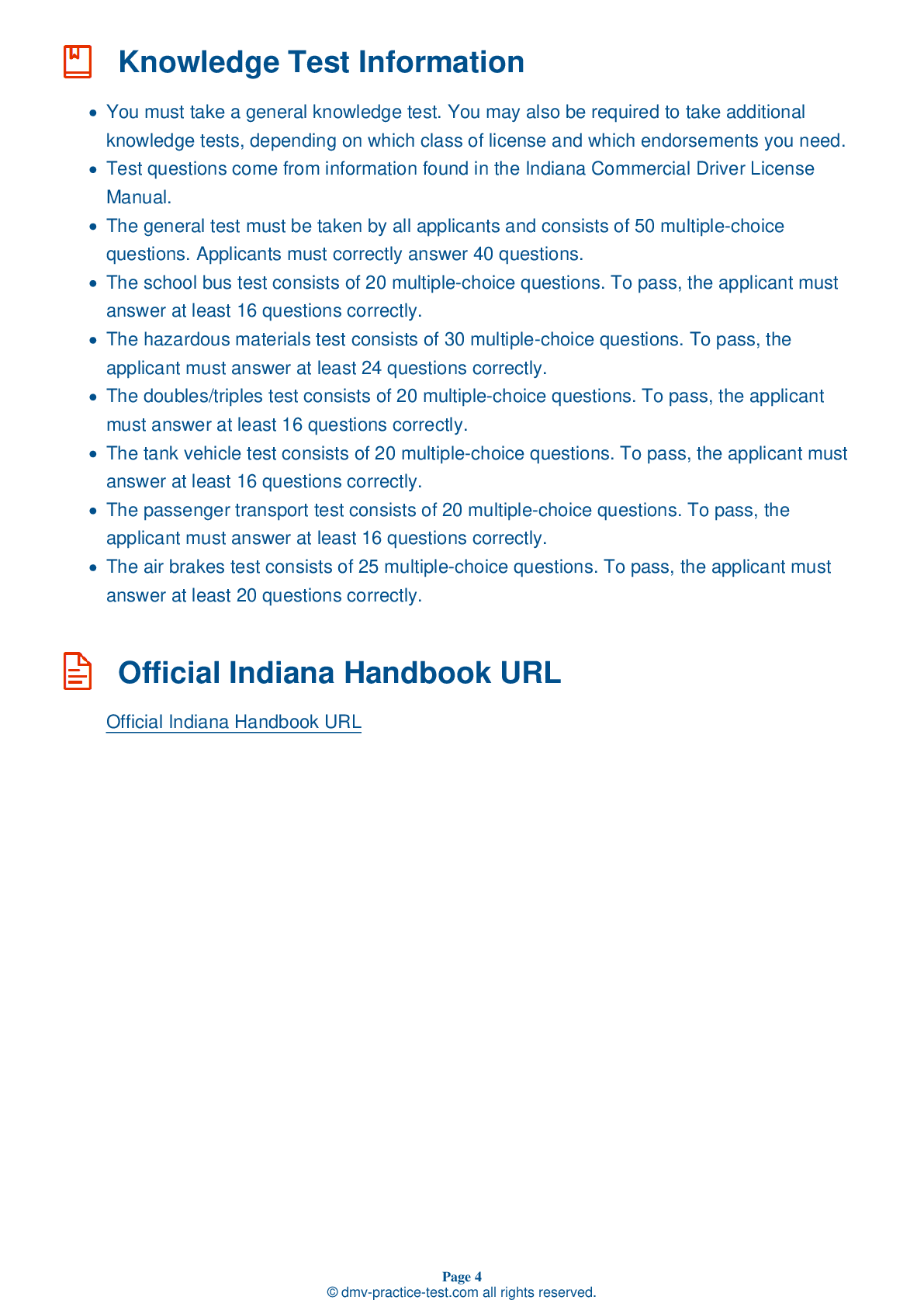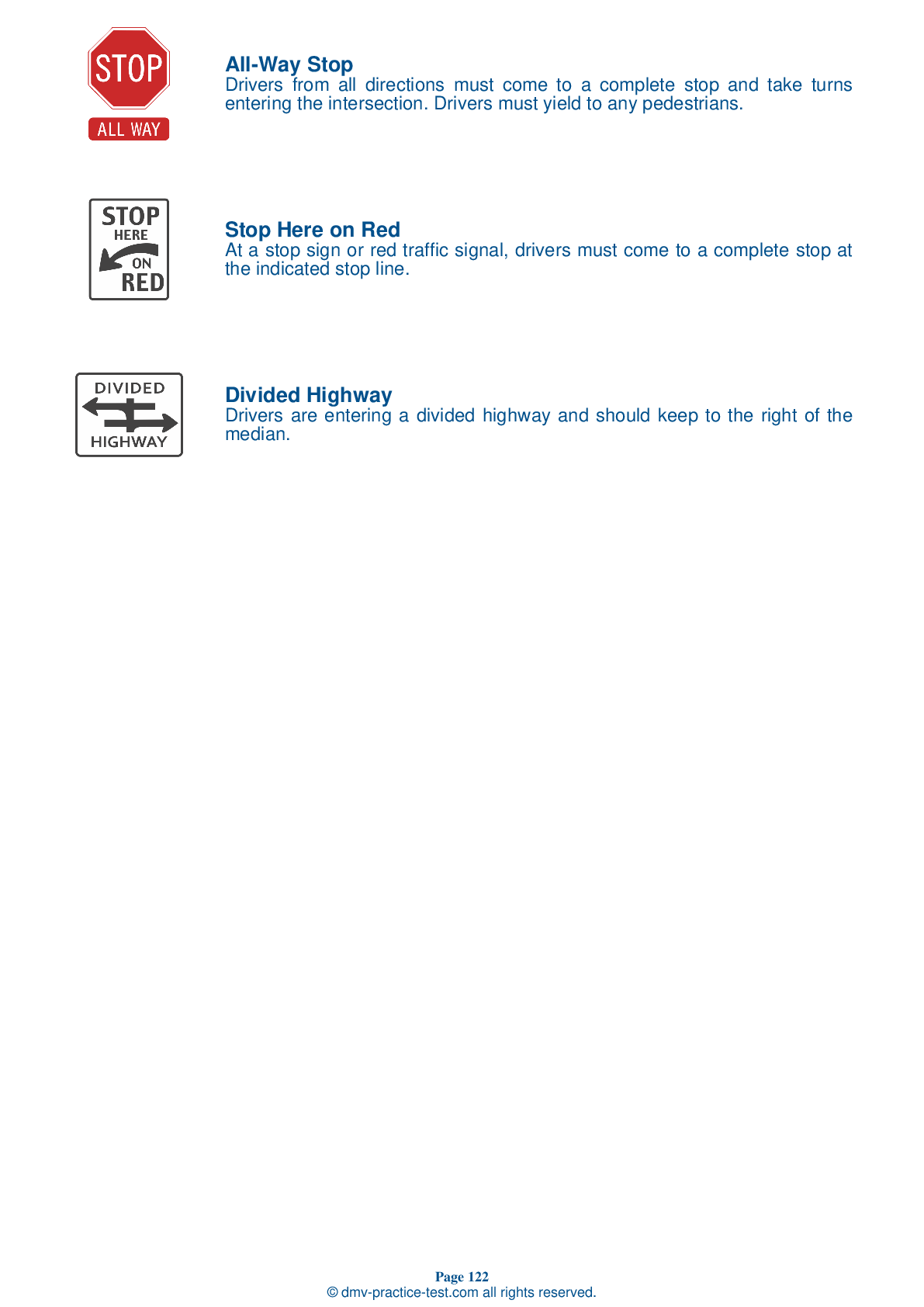Knowledge Test Class B #2
Class B Driving Test | Indiana 2025 #2 Page 5 of 7
Train for FREE online with our Indiana class B license test. The official exam test consists of several obligatory parts, with all of them checking your knowledge of different blocks of road rules. If you need to obtain a IN CDL class B permit in 2025, practice as much as possible. Free sample tests published on our website will help you check and improve your knowledge and boost your grades. Please bear in mind that CDL class B requirements may vary from state to state.
50
40
20
29 . Examples of serious traffic violations include each of the following offenses, except:
Not stopping behind the stop line at a stop sign.
Traffic violations classified as "serious" include excessive speeding, reckless driving, operating a CMV without a valid CDL, following other vehicles too closely, and improper lane usage. Consequences for multiple serious traffic violations can result in license disqualification.
30 . If a person has a hazardous materials endorsement and renounces their U.S. citizenship:
They must surrender their hazardous materials endorsement within 24 hours.
If applicable, you must surrender your hazardous materials endorsement within 24 hours of renouncing your U.S. citizenship.
31 . If traveling across state lines:
A driver should have only one license.
It is prohibited for any person to have more than one driver license. All states share drivers' information in a computer database to help prevent issuance of licenses to drivers who already have them.
32 . Failing to exit your vehicle properly during an exercise in the basic vehicle control skills test will result in:
An extra point against your score.
When exiting your vehicle during the basic vehicle control skills test, you must face the vehicle and maintain three points of contact at all times. If your testing vehicle is a bus, you must maintain contact with the handrail. Exiting the vehicle incorrectly may result in automatic failure of the basic control skills test.
33 . Violating an out-of-service order twice within a 10-year period will result in losing your CDL for:
Life.
If you are convicted for a second time within a 10-year period of violating out-of-service orders, you will lose your CDL for at least one year.
34 . What color is the low air pressure warning light?
Purple
A low air pressure warning signal is required in vehicles with air brakes. The warning light is usually red and may be accompanied by a buzzer.
35 . What can rust around the wheel nuts indicate?
That the nuts are the wrong size.
Rust around wheel nuts can indicate that they are loose. If you observe rust, check the tightness of the nuts.
Search the best driving school in your neighbourhood
2025 Indiana | Frequently Asked Questions
To acquire a CDL Hazmat endorsement in Indiana, you must hold a valid CDL. Then, pass the Hazardous Materials Endorsement Knowledge Test at a BMV branch. After passing, submit fingerprints for a federal TSA background check. Once cleared, you'll receive your endorsement. Remember, the endorsement must be renewed every five years with a new background check.
To obtain a CDL Hazmat license in Indiana, you must first have a commercial driver's license (CDL). Then, you'll need to pass the Hazardous Materials Endorsement Knowledge Test, provide proof of U.S. citizenship or lawful permanent residency, and pass a TSA background check. Finally, you must submit a self-certification form and medical examiner's certificate.
To apply for a CDL Hazmat endorsement in Indiana, you must provide: proof of U.S. citizenship or lawful permanent residency (e.g., passport, birth certificate), your current CDL, proof of Indiana residency, and a completed application. Additionally, a medical examiner's certificate and a self-certification form are required. Lastly, you'll need documentation confirming you passed the TSA background check.
Yes, there is a dedicated written test for the CDL Hazmat endorsement in Indiana. The Hazardous Materials Endorsement Knowledge Test is designed to evaluate your understanding of the regulations and safety procedures associated with transporting hazardous materials. It's important to prepare thoroughly for this test using the Indiana CDL manual or other study materials.
The written test for the CDL Hazmat endorsement covers several subjects including: understanding hazard classifications, recognizing placards and labels, transporting hazardous materials safely, loading and unloading hazardous materials, and handling emergencies or accidents involving hazardous materials. It also tests knowledge about federal and state regulations for transporting such materials.
Yes, there are extra charges associated with acquiring a CDL Hazmat endorsement in Indiana. These include fees for the knowledge test, endorsement application, and fingerprinting for the TSA background check. The exact fees can vary, so it's recommended to check with the Indiana Bureau of Motor Vehicles or the TSA for current pricing.
Yes, background checks and security clearances are mandatory for the CDL Hazmat endorsement in Indiana. The Transportation Security Administration (TSA) conducts a fingerprint-based Criminal History Records Check and a security threat assessment to ensure the applicant does not pose a security threat. This is a federal requirement for all states.
Yes, specialized training is required for the CDL Hazmat endorsement. You must pass a written test that covers topics like handling hazardous materials, recognizing placards and labels, and emergency procedures. After passing, you'll receive a certificate of training which is mandatory when applying for the endorsement. Regular refresher training is also required.
No, you cannot legally transport hazardous materials without a valid CDL Hazmat endorsement in Indiana. The endorsement ensures that drivers have the necessary training and knowledge to handle and transport hazardous materials safely. Violating this requirement can result in significant fines and penalties.
Yes, you can add the CDL Hazmat endorsement to your current CDL license. It doesn't require a new application for a CDL, but you must pass the Hazmat knowledge test, pay the endorsement fee, and successfully complete the TSA background check and fingerprinting.




